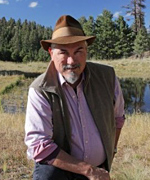—by Alan Dulaney

Yes, we are still in a drought. California went ahead and declared the drought’s end on the basis of one wet winter, but that hardly seems prudent. ADWR reports drought at only moderate levels for southern and central Arizona. Although January and February brought snow to the high country, Arizona recognizes that a 17-year drought doesn’t end overnight (usually). But it can pause for a year.
The Salt-Verde River system benefited from the winter precipitation, according to SRP. The Verde system is 70% full and the Salt is 74% full, with the total system at 73%, which is much better than the 55% of 1 year ago. Given that SRP water deliveries have declined over the last decade or two, this means sufficient water for SRP customers (mostly cities now, which have stabilized demand) for years to come. Yet fire on the watershed remains a huge threat.

The Colorado River Basin also received above-average precipitation this winter. Lake Powell is 57% full and still rising. This foretells a release to Lake Mead, which remains only 39% full, sufficient to stave off a declaration of shortage for 2018, and perhaps for 2019 and 2020 as well. Tiered shortage levels set up in 2007 are tied to falling water level elevations in Lake Mead. The photo above shows water levels at 1081 feet. At 1075 feet, the first shortage is declared, and Arizona is cut 320,000 acre-feet of excess and agricultural water, all from the CAP canal. More cuts come at 1050 and 1025 feet, but below that point nothing is clear. California never takes a cut under these criteria.
One thing not on hold because of the wet winter is the structural deficit, in which more water must be delivered to the Lower Basin states and Mexico from Lake Mead than can flow in from Lake Powell and other streams (unregulated flow). In truth, the structural deficit is responsible for the ever-declining levels in Lake Mead. Outflows must match inflows. The imbalance cannot be cured by one wet winter.
Also on hold are negotiations for the Drought Contingency Plan (DCP). For a variety of reasons, the Lower Basin states are not yet ready to ink the deal to ensure that deliveries are curtailed such that outflows don’t exceed inflows. Yet the snows of January and February have provided a window during which the states can get their ducks in a row and agree on how to cut demands on the available supply. And it might take much of this window to cobble together the internal deals each state needs to come to the table ready to sign any DCP deal. Arizona must achieve agreement amongst all sectors (agriculture, M&I, and tribal) on a deal to cut demand, lest the inexorable decline in Lake Mead continue.
Meteorological phenomena are fickle; droughts can resume. Hydrologists cannot let up on this message. We must continue our vigilance, our stewardship, and our planning.
On June 2, I took this photo at Hoover Dam. Take a look—it’s a long way down to the waterline.